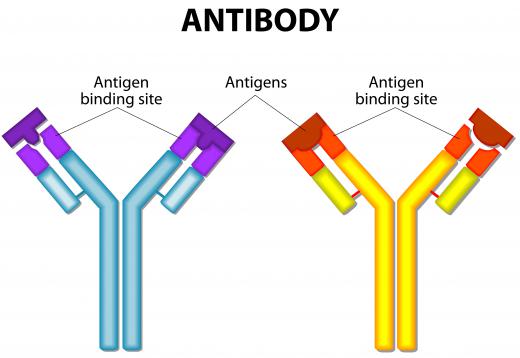What Is an IHC Antibody?
An immunohistochemical (IHC) antibody is a reagent commonly used in scientific studies to tag antigens of interest. An antigen is any small molecule that can cause an immune reaction that forces antibody production against that singular antigen. Based on the mammalian immune system, antibody production is a single step in a process of identifying material as foreign so that the body can then attack and expel the invasive substance, whether it's a virus, a bacterial infection or a small molecule such as pollen.
Antibodies can have tremendous specificity and binding ability in tagging antigens. That specificity is exploited to the benefit of scientists when antibody production is geared toward the identification of specific antigens of interest. A thin section of tissue can be stained with an antibody so that the experimenter can easily identify all the antigen sites present in that sample. Many companies specialize in antibody creation, causing a vast collective antibody catalog to be available to scientists and experimenters.

An IHC antibody is used in different experimental techniques. Antibody staining in thin sections of tissue embedded in paraffin or plastic is often used so antigens can be found in situ. An IHC antibody also can be used in experimental precipitation techniques such as a co-immunoprecipitation assay, focusing on bringing antigens out of solution to quantify the amount of antigen present in a large piece of tissue. Assays that measure the amount of light that is able to pass through a tissue culture plate well after a supernatant has been exposed to the bottom of a well-pre-coated IHC antibody are also often used to quantify the amount of an antigen in a homogenized tissue sample.

It's possible to have antibody staining protocols that rely on the use of a single antibody for antigen detection. These protocols usually are used on tissue samples that are embedded in a non-reactive substrate and mounted on a glass slide. These single-antibody staining procedures are also popular in laboratories that tag their own antibodies with detection molecules such as fluorophores.
More commonly, however, antibody staining protocols require the use of primary and secondary antibodies. A primary IHC antibody is raised against a specific antigen, which might be uncommonly studied. A secondary IHC antibody will be raised against the primary IHC antibody. The secondary antibody will be tagged, however, to an identifying molecule such as biotin or a fluorophore. This two-antibody technique is common because companies save money adding fluorophores or expensive tagging reagents to large quantities of antibodies raised against the immune markers of a certain species rather than tagging expensive reagents to an antibody raised against an antigen that might be studied by very few scientists.
AS FEATURED ON:
AS FEATURED ON:












Discuss this Article
Post your comments